turn signal CADILLAC LYRIC 2023 Owner's Manual
[x] Cancel search | Manufacturer: CADILLAC, Model Year: 2023, Model line: LYRIC, Model: CADILLAC LYRIC 2023Pages: 424, PDF Size: 4.76 MB
Page 232 of 424
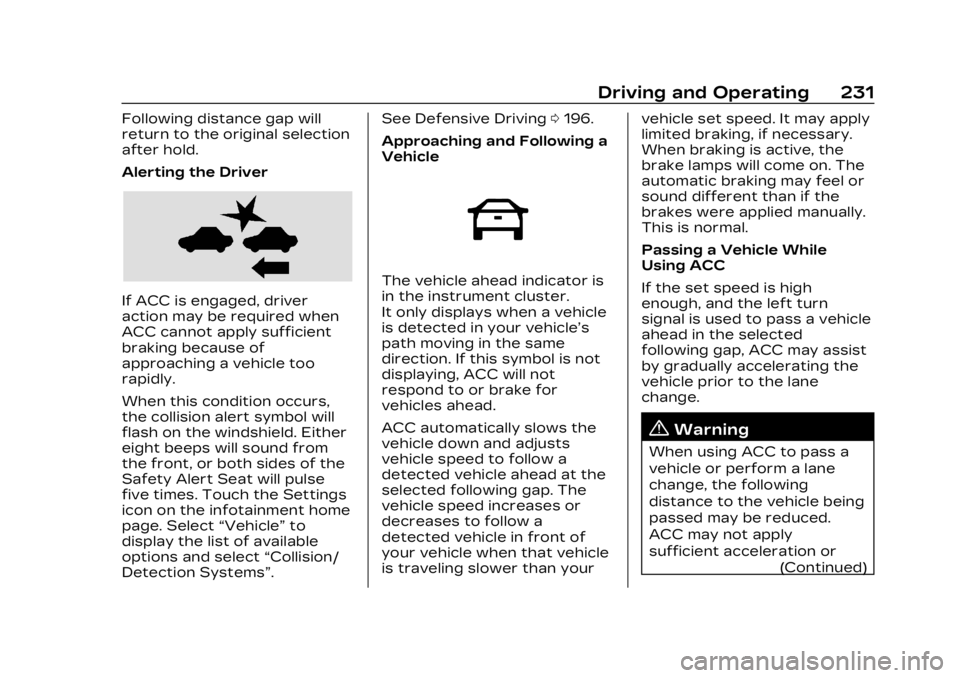
Cadillac Lyriq Owner Manual (GMNA-Localizing-U.S./Canada-15644413) -
2023 - CRC - 2/23/22
Driving and Operating 231
Following distance gap will
return to the original selection
after hold.
Alerting the Driver
If ACC is engaged, driver
action may be required when
ACC cannot apply sufficient
braking because of
approaching a vehicle too
rapidly.
When this condition occurs,
the collision alert symbol will
flash on the windshield. Either
eight beeps will sound from
the front, or both sides of the
Safety Alert Seat will pulse
five times. Touch the Settings
icon on the infotainment home
page. Select“Vehicle”to
display the list of available
options and select “Collision/
Detection Systems”. See Defensive Driving
0196.
Approaching and Following a
Vehicle
The vehicle ahead indicator is
in the instrument cluster.
It only displays when a vehicle
is detected in your vehicle’s
path moving in the same
direction. If this symbol is not
displaying, ACC will not
respond to or brake for
vehicles ahead.
ACC automatically slows the
vehicle down and adjusts
vehicle speed to follow a
detected vehicle ahead at the
selected following gap. The
vehicle speed increases or
decreases to follow a
detected vehicle in front of
your vehicle when that vehicle
is traveling slower than your vehicle set speed. It may apply
limited braking, if necessary.
When braking is active, the
brake lamps will come on. The
automatic braking may feel or
sound different than if the
brakes were applied manually.
This is normal.
Passing a Vehicle While
Using ACC
If the set speed is high
enough, and the left turn
signal is used to pass a vehicle
ahead in the selected
following gap, ACC may assist
by gradually accelerating the
vehicle prior to the lane
change.
{Warning
When using ACC to pass a
vehicle or perform a lane
change, the following
distance to the vehicle being
passed may be reduced.
ACC may not apply
sufficient acceleration or
(Continued)
Page 238 of 424
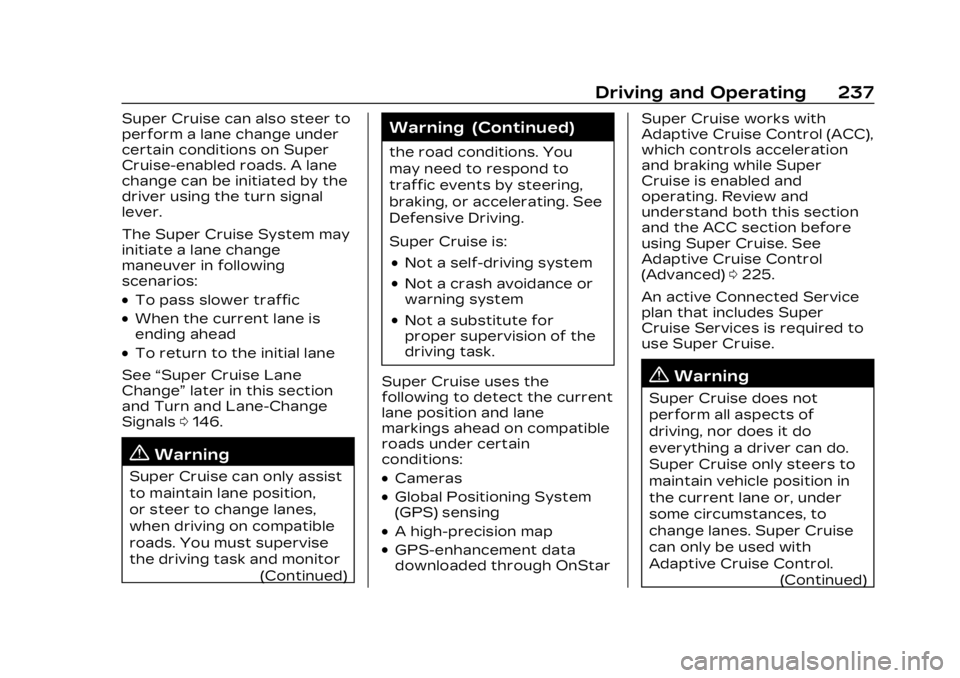
Cadillac Lyriq Owner Manual (GMNA-Localizing-U.S./Canada-15644413) -
2023 - CRC - 2/23/22
Driving and Operating 237
Super Cruise can also steer to
perform a lane change under
certain conditions on Super
Cruise-enabled roads. A lane
change can be initiated by the
driver using the turn signal
lever.
The Super Cruise System may
initiate a lane change
maneuver in following
scenarios:
.To pass slower traffic
.When the current lane is
ending ahead
.To return to the initial lane
See “Super Cruise Lane
Change” later in this section
and Turn and Lane-Change
Signals 0146.
{Warning
Super Cruise can only assist
to maintain lane position,
or steer to change lanes,
when driving on compatible
roads. You must supervise
the driving task and monitor
(Continued)
Warning (Continued)
the road conditions. You
may need to respond to
traffic events by steering,
braking, or accelerating. See
Defensive Driving.
Super Cruise is:
.Not a self-driving system
.Not a crash avoidance or
warning system
.Not a substitute for
proper supervision of the
driving task.
Super Cruise uses the
following to detect the current
lane position and lane
markings ahead on compatible
roads under certain
conditions:
.Cameras
.Global Positioning System
(GPS) sensing
.A high-precision map
.GPS-enhancement data
downloaded through OnStar Super Cruise works with
Adaptive Cruise Control (ACC),
which controls acceleration
and braking while Super
Cruise is enabled and
operating. Review and
understand both this section
and the ACC section before
using Super Cruise. See
Adaptive Cruise Control
(Advanced)
0225.
An active Connected Service
plan that includes Super
Cruise Services is required to
use Super Cruise.
{Warning
Super Cruise does not
perform all aspects of
driving, nor does it do
everything a driver can do.
Super Cruise only steers to
maintain vehicle position in
the current lane or, under
some circumstances, to
change lanes. Super Cruise
can only be used with
Adaptive Cruise Control. (Continued)
Page 242 of 424
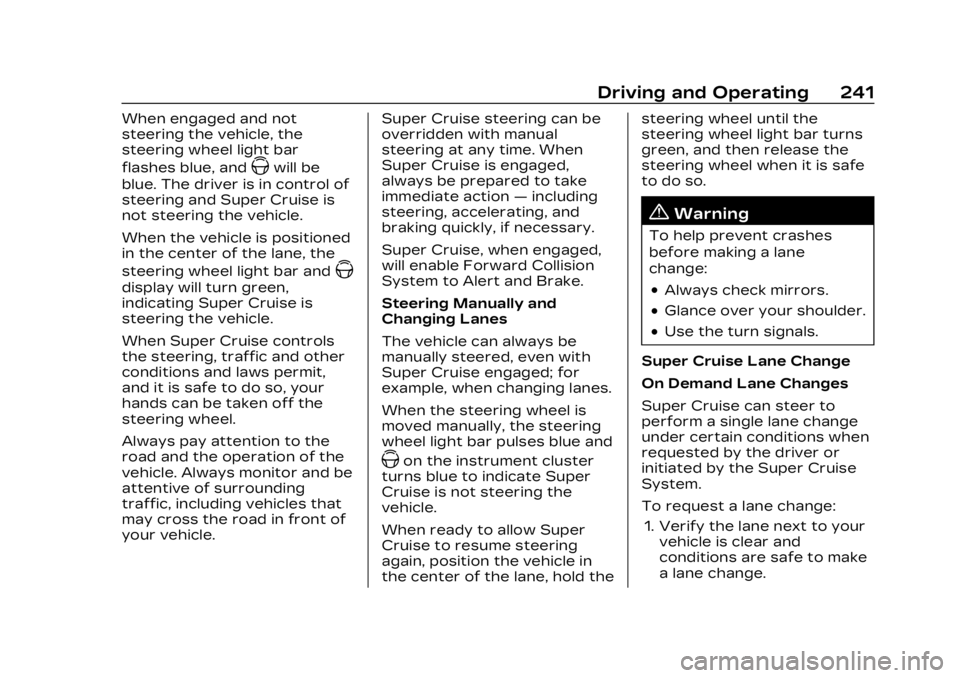
Cadillac Lyriq Owner Manual (GMNA-Localizing-U.S./Canada-15644413) -
2023 - CRC - 2/23/22
Driving and Operating 241
When engaged and not
steering the vehicle, the
steering wheel light bar
flashes blue, and
Zwill be
blue. The driver is in control of
steering and Super Cruise is
not steering the vehicle.
When the vehicle is positioned
in the center of the lane, the
steering wheel light bar and
Z
display will turn green,
indicating Super Cruise is
steering the vehicle.
When Super Cruise controls
the steering, traffic and other
conditions and laws permit,
and it is safe to do so, your
hands can be taken off the
steering wheel.
Always pay attention to the
road and the operation of the
vehicle. Always monitor and be
attentive of surrounding
traffic, including vehicles that
may cross the road in front of
your vehicle. Super Cruise steering can be
overridden with manual
steering at any time. When
Super Cruise is engaged,
always be prepared to take
immediate action
—including
steering, accelerating, and
braking quickly, if necessary.
Super Cruise, when engaged,
will enable Forward Collision
System to Alert and Brake.
Steering Manually and
Changing Lanes
The vehicle can always be
manually steered, even with
Super Cruise engaged; for
example, when changing lanes.
When the steering wheel is
moved manually, the steering
wheel light bar pulses blue and
Zon the instrument cluster
turns blue to indicate Super
Cruise is not steering the
vehicle.
When ready to allow Super
Cruise to resume steering
again, position the vehicle in
the center of the lane, hold the steering wheel until the
steering wheel light bar turns
green, and then release the
steering wheel when it is safe
to do so.
{Warning
To help prevent crashes
before making a lane
change:
.Always check mirrors.
.Glance over your shoulder.
.Use the turn signals.
Super Cruise Lane Change
On Demand Lane Changes
Super Cruise can steer to
perform a single lane change
under certain conditions when
requested by the driver or
initiated by the Super Cruise
System.
To request a lane change: 1. Verify the lane next to your vehicle is clear and
conditions are safe to make
a lane change.
Page 243 of 424

Cadillac Lyriq Owner Manual (GMNA-Localizing-U.S./Canada-15644413) -
2023 - CRC - 2/23/22
242 Driving and Operating
2. Use the turn signal lever toactivate the turn signal in
the direction of the desired
lane change.
3. Return the turn signal lever to the neutral position after
the lane change. See Turn
and Lane-Change Signals
0146.
4. To cancel a lane change, return the turn signal lever
to the neutral position,
move the lever in the
opposite direction of the
lane change, or steer
manually at any time.
Automatic Lane Changes
Super Cruise System may
initiate a single lane change
when enabled through Vehicle
Personalization under
following conditions:
.The Super Cruise System
may initiate an automatic
lane change to the left to
pass a slower moving vehicle
ahead and a subsequent
lane change to right to
return to your original lane.
.Super Cruise System may
initiate an automatic lane
change to left or right when
current lane is ending ahead.
.To cancel a Super Cruise
lane change, move the turn
signal lever or steer manually
at any time..
If Super Cruise detects that
traffic is clear, Super Cruise
will steer the vehicle to
perform the lane change.
A message appears on the
Driver Information Center
(DIC) during the lane change to
provide more information on
the status of the lane change.
Super Cruise Lane Change
functionality is only available
on Super Cruise capable
Divided Roads.
Super Cruise Lane Change
may be disabled when a trailer
or other accessories (e.g. bike
rack, cargo tray, etc.) are
detected.
Do not use Super Cruise Lane
Change when towing a trailer. The Super Cruise Lane
Change feature can be
customized to be Off, On
Demand Lane Change, or On
Demand Lane Change &
Automatic Lane Change
through the vehicle
personalization menu. Touch
the Settings icon on the
infotainment home page.
Select "Vehicle" to display the
list of available options and
select "Super Cruise Lane
Change".
{Warning
Super Cruise Lane Change
may not detect a vehicle in
an adjacent lane. Always
supervise the driving task
and monitor traffic
conditions when using the
Super Cruise Lane Change
feature. Only request a lane
change when traffic
conditions are safe for a
lane change, and always be
ready to manually steer the
(Continued)
Page 264 of 424
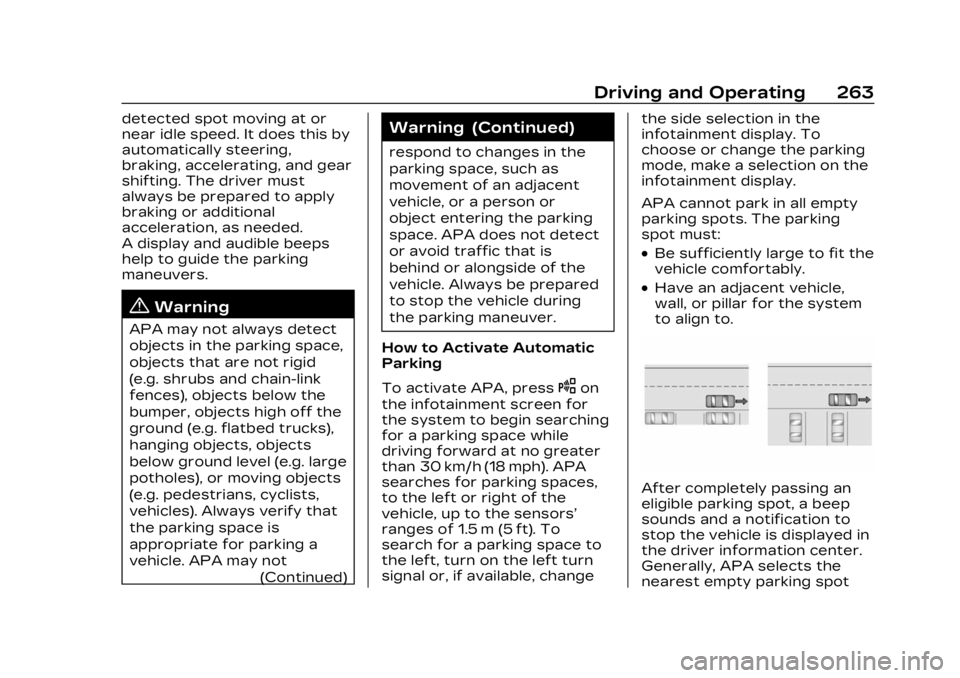
Cadillac Lyriq Owner Manual (GMNA-Localizing-U.S./Canada-15644413) -
2023 - CRC - 2/23/22
Driving and Operating 263
detected spot moving at or
near idle speed. It does this by
automatically steering,
braking, accelerating, and gear
shifting. The driver must
always be prepared to apply
braking or additional
acceleration, as needed.
A display and audible beeps
help to guide the parking
maneuvers.
{Warning
APA may not always detect
objects in the parking space,
objects that are not rigid
(e.g. shrubs and chain-link
fences), objects below the
bumper, objects high off the
ground (e.g. flatbed trucks),
hanging objects, objects
below ground level (e.g. large
potholes), or moving objects
(e.g. pedestrians, cyclists,
vehicles). Always verify that
the parking space is
appropriate for parking a
vehicle. APA may not(Continued)
Warning (Continued)
respond to changes in the
parking space, such as
movement of an adjacent
vehicle, or a person or
object entering the parking
space. APA does not detect
or avoid traffic that is
behind or alongside of the
vehicle. Always be prepared
to stop the vehicle during
the parking maneuver.
How to Activate Automatic
Parking
To activate APA, press
Oon
the infotainment screen for
the system to begin searching
for a parking space while
driving forward at no greater
than 30 km/h (18 mph). APA
searches for parking spaces,
to the left or right of the
vehicle, up to the sensors’
ranges of 1.5 m (5 ft). To
search for a parking space to
the left, turn on the left turn
signal or, if available, change the side selection in the
infotainment display. To
choose or change the parking
mode, make a selection on the
infotainment display.
APA cannot park in all empty
parking spots. The parking
spot must:
.Be sufficiently large to fit the
vehicle comfortably.
.Have an adjacent vehicle,
wall, or pillar for the system
to align to.
After completely passing an
eligible parking spot, a beep
sounds and a notification to
stop the vehicle is displayed in
the driver information center.
Generally, APA selects the
nearest empty parking spot
Page 278 of 424
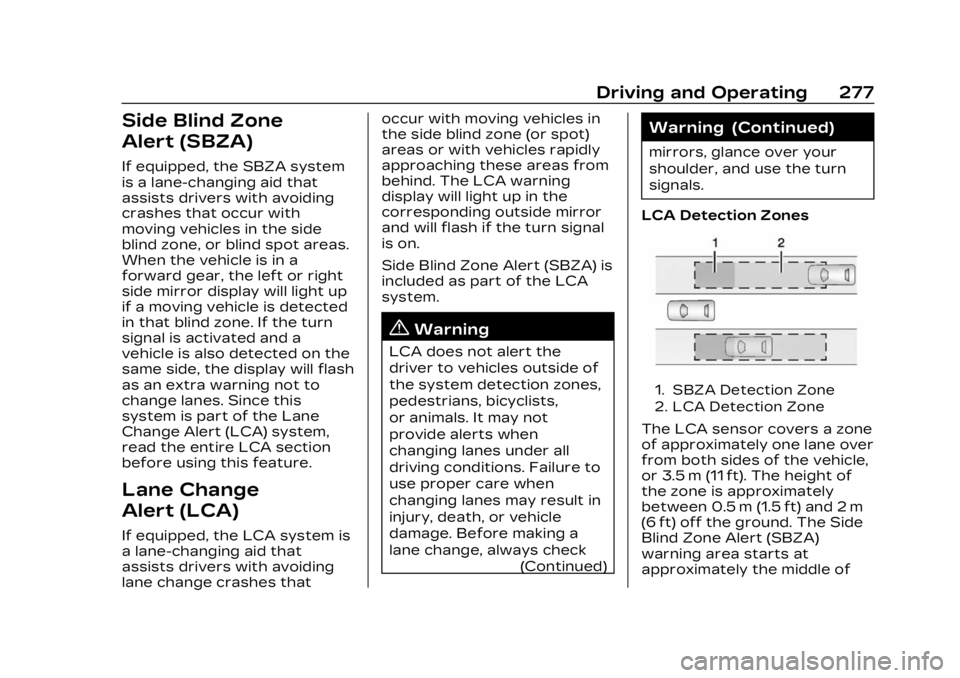
Cadillac Lyriq Owner Manual (GMNA-Localizing-U.S./Canada-15644413) -
2023 - CRC - 2/23/22
Driving and Operating 277
Side Blind Zone
Alert (SBZA)
If equipped, the SBZA system
is a lane-changing aid that
assists drivers with avoiding
crashes that occur with
moving vehicles in the side
blind zone, or blind spot areas.
When the vehicle is in a
forward gear, the left or right
side mirror display will light up
if a moving vehicle is detected
in that blind zone. If the turn
signal is activated and a
vehicle is also detected on the
same side, the display will flash
as an extra warning not to
change lanes. Since this
system is part of the Lane
Change Alert (LCA) system,
read the entire LCA section
before using this feature.
Lane Change
Alert (LCA)
If equipped, the LCA system is
a lane-changing aid that
assists drivers with avoiding
lane change crashes thatoccur with moving vehicles in
the side blind zone (or spot)
areas or with vehicles rapidly
approaching these areas from
behind. The LCA warning
display will light up in the
corresponding outside mirror
and will flash if the turn signal
is on.
Side Blind Zone Alert (SBZA) is
included as part of the LCA
system.
{Warning
LCA does not alert the
driver to vehicles outside of
the system detection zones,
pedestrians, bicyclists,
or animals. It may not
provide alerts when
changing lanes under all
driving conditions. Failure to
use proper care when
changing lanes may result in
injury, death, or vehicle
damage. Before making a
lane change, always check
(Continued)
Warning (Continued)
mirrors, glance over your
shoulder, and use the turn
signals.
LCA Detection Zones
1. SBZA Detection Zone
2. LCA Detection Zone
The LCA sensor covers a zone
of approximately one lane over
from both sides of the vehicle,
or 3.5 m (11 ft). The height of
the zone is approximately
between 0.5 m (1.5 ft) and 2 m
(6 ft) off the ground. The Side
Blind Zone Alert (SBZA)
warning area starts at
approximately the middle of
Page 279 of 424

Cadillac Lyriq Owner Manual (GMNA-Localizing-U.S./Canada-15644413) -
2023 - CRC - 2/23/22
278 Driving and Operating
the vehicle and goes back 5 m
(16 ft). Drivers are also warned
of vehicles rapidly
approaching from up to 70 m
(230 ft) behind the vehicle.
How the System Works
The LCA symbol lights up in
the side mirrors when the
system detects a moving
vehicle in the next lane over
that is in the side blind zone or
rapidly approaching that zone
from behind. A lit LCA symbol
indicates it may be unsafe to
change lanes. Before making a
lane change, check the LCA
display, check mirrors, glance
over your shoulder, and use
the turn signals.
Left Side
Mirror DisplayRight Side
Mirror Display When the vehicle is started,
both outside mirror LCA
displays will briefly come on to
indicate the system is
operating. When the vehicle is
in a forward gear, the left or
right side mirror display will
light up if a moving vehicle is
detected in the next lane over
in that blind zone or rapidly
approaching that zone. If the
turn signal is activated in the
same direction as a detected
vehicle, this display will flash
as an extra warning not to
change lanes.
LCA can be disabled through
vehicle personalization.To view
available settings from the
infotainment screen, touch
Settings > Vehicle > Collision/
Detection Systems. If LCA is
disabled by the driver, the LCA
mirror displays will not light up.
When the System Does
Not Seem to Work
Properly
The LCA system requires
some driving for the system to
calibrate to maximum
performance. This calibration
may occur more quickly if the
vehicle is driven on a straight
highway road with traffic and
roadside objects (e.g.,
guardrails, barriers).
LCA displays may not come on
when passing a vehicle quickly
or for a stopped vehicle. LCA
may alert to objects attached
to the vehicle, such as a
bicycle, or object extending
out to either side of the
vehicle. Attached objects may
also interfere with the
detection of vehicles. This is
normal system operation; the
vehicle does not need service.
LCA may not always alert the
driver to vehicles in the next
lane over, especially in wet
conditions or when driving on
sharp curves. The system
Page 280 of 424
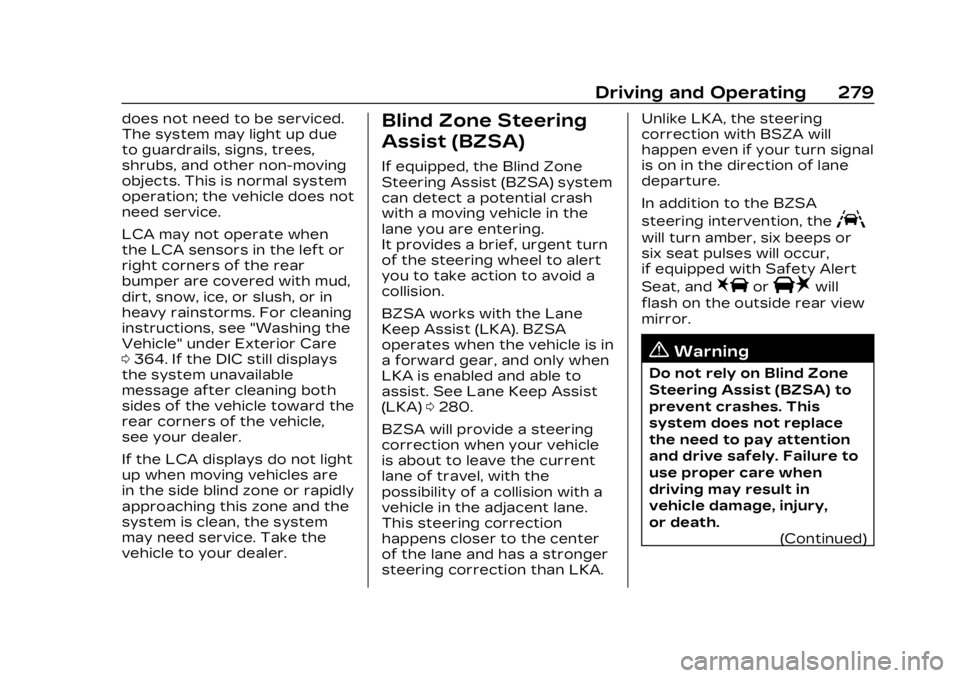
Cadillac Lyriq Owner Manual (GMNA-Localizing-U.S./Canada-15644413) -
2023 - CRC - 2/23/22
Driving and Operating 279
does not need to be serviced.
The system may light up due
to guardrails, signs, trees,
shrubs, and other non-moving
objects. This is normal system
operation; the vehicle does not
need service.
LCA may not operate when
the LCA sensors in the left or
right corners of the rear
bumper are covered with mud,
dirt, snow, ice, or slush, or in
heavy rainstorms. For cleaning
instructions, see "Washing the
Vehicle" under Exterior Care
0364. If the DIC still displays
the system unavailable
message after cleaning both
sides of the vehicle toward the
rear corners of the vehicle,
see your dealer.
If the LCA displays do not light
up when moving vehicles are
in the side blind zone or rapidly
approaching this zone and the
system is clean, the system
may need service. Take the
vehicle to your dealer.Blind Zone Steering
Assist (BZSA)
If equipped, the Blind Zone
Steering Assist (BZSA) system
can detect a potential crash
with a moving vehicle in the
lane you are entering.
It provides a brief, urgent turn
of the steering wheel to alert
you to take action to avoid a
collision.
BZSA works with the Lane
Keep Assist (LKA). BZSA
operates when the vehicle is in
a forward gear, and only when
LKA is enabled and able to
assist. See Lane Keep Assist
(LKA) 0280.
BZSA will provide a steering
correction when your vehicle
is about to leave the current
lane of travel, with the
possibility of a collision with a
vehicle in the adjacent lane.
This steering correction
happens closer to the center
of the lane and has a stronger
steering correction than LKA. Unlike LKA, the steering
correction with BSZA will
happen even if your turn signal
is on in the direction of lane
departure.
In addition to the BZSA
steering intervention, the
A
will turn amber, six beeps or
six seat pulses will occur,
if equipped with Safety Alert
Seat, and
8or|will
flash on the outside rear view
mirror.
{Warning
Do not rely on Blind Zone
Steering Assist (BZSA) to
prevent crashes. This
system does not replace
the need to pay attention
and drive safely. Failure to
use proper care when
driving may result in
vehicle damage, injury,
or death.
(Continued)
Page 281 of 424

Cadillac Lyriq Owner Manual (GMNA-Localizing-U.S./Canada-15644413) -
2023 - CRC - 2/23/22
280 Driving and Operating
Warning (Continued)
.BZSA performance may
be affected by weather
and road conditions.
.BZSA does not provide
steering assistance to
avoid a vehicle that is in,
or has entered, your lane
of travel.
.BZSA will not prevent a
towed trailer from
crossing into the adjacent
lane. Always monitor the
trailer position while
towing to ensure it is in
the same lane as your
vehicle. BZSA is only
designed to detect when
your vehicle
unintentionally crosses
detected lane lines.
Lane Keep
Assist (LKA)
If equipped, LKA may help
avoid crashes due to
unintentional lane departures.
This system uses a camera todetect lane markings. The LKA
may be ready to assist at
speeds between
80 km/h (50 mph) and 180
km/h (112 mph). LKA may assist
by gently turning the steering
wheel if the vehicle
approaches a detected lane
marking. It may also provide a
Lane Departure Warning
(LDW) alert if the vehicle
crosses a detected lane
marking. This system is not
intended to keep the vehicle
centered in the lane. LKA will
not assist and alert if the turn
signal is active in the direction
of lane departure, or if it
detects that you are
accelerating, braking or
actively steering. LKA can be
overridden by turning the
steering wheel. If the system
detects you are steering
intentionally across a lane
marker, the LDW will not be
given. Do not expect the LDW
to occur when you are
intentionally crossing a lane
marker.
{Warning
The LKA system does not
continuously steer the
vehicle. It may not keep the
vehicle in the lane or give a
Lane Departure Warning
(LDW) alert, even if a lane
marking is detected.
The LKA and LDW systems
may not:
.Provide an alert or enough
steering assist to avoid a
lane departure or crash.
.Detect lane markings
under poor weather or
visibility conditions. This
can occur if the windshield
or headlamps are blocked
by dirt, snow, or ice; if they
are not in proper
condition; or if the sun
shines directly into the
camera.
.Detect road edges.
.Detect lanes on winding or
hilly roads.
(Continued)
Page 299 of 424
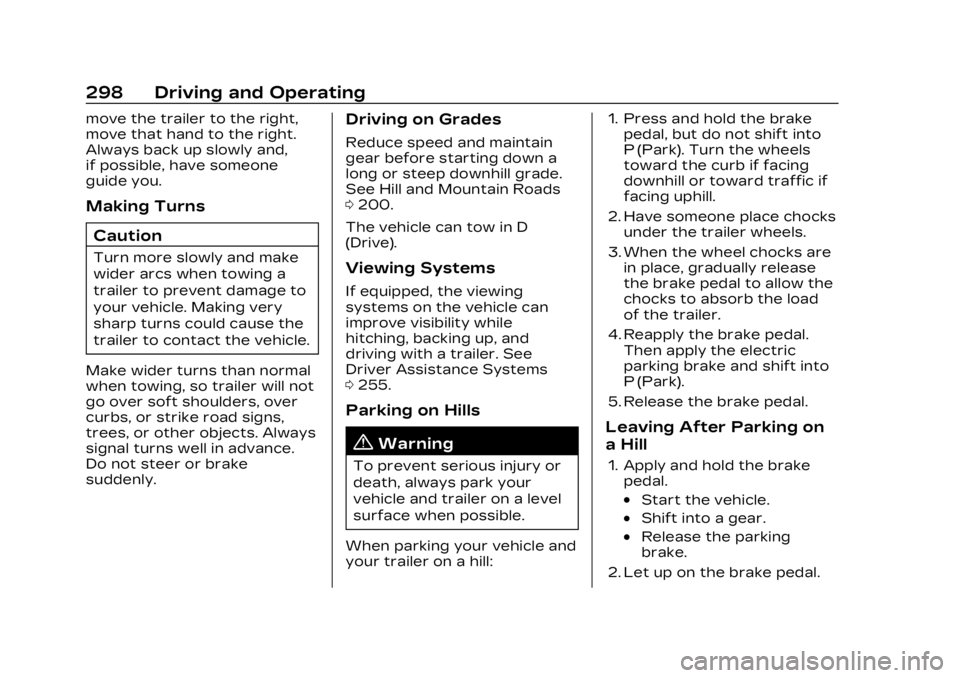
Cadillac Lyriq Owner Manual (GMNA-Localizing-U.S./Canada-15644413) -
2023 - CRC - 2/23/22
298 Driving and Operating
move the trailer to the right,
move that hand to the right.
Always back up slowly and,
if possible, have someone
guide you.
Making TurnsCaution
Turn more slowly and make
wider arcs when towing a
trailer to prevent damage to
your vehicle. Making very
sharp turns could cause the
trailer to contact the vehicle.
Make wider turns than normal
when towing, so trailer will not
go over soft shoulders, over
curbs, or strike road signs,
trees, or other objects. Always
signal turns well in advance.
Do not steer or brake
suddenly.
Driving on Grades
Reduce speed and maintain
gear before starting down a
long or steep downhill grade.
See Hill and Mountain Roads
0 200.
The vehicle can tow in D
(Drive).
Viewing Systems
If equipped, the viewing
systems on the vehicle can
improve visibility while
hitching, backing up, and
driving with a trailer. See
Driver Assistance Systems
0 255.
Parking on Hills
{Warning
To prevent serious injury or
death, always park your
vehicle and trailer on a level
surface when possible.
When parking your vehicle and
your trailer on a hill: 1. Press and hold the brake
pedal, but do not shift into
P (Park). Turn the wheels
toward the curb if facing
downhill or toward traffic if
facing uphill.
2. Have someone place chocks under the trailer wheels.
3. When the wheel chocks are in place, gradually release
the brake pedal to allow the
chocks to absorb the load
of the trailer.
4. Reapply the brake pedal. Then apply the electric
parking brake and shift into
P (Park).
5. Release the brake pedal.
Leaving After Parking on
a Hill
1. Apply and hold the brake pedal.
.Start the vehicle.
.Shift into a gear.
.Release the parking
brake.
2. Let up on the brake pedal.